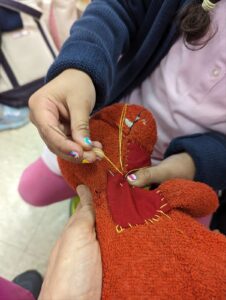Hazel can be reluctant to try things. When she hesitated, we talked about the task and recited our class poem—
I’ve got a big beautiful brain and an awesome heart.
I’m brave.
I’m kind.
I’m mighty.
I can do hard things and
I’m ready to learn.
Oh yeah,
I’m ready to learn!
Shyness Is a Pause—a Comma
Often, the conversation and affirmations were enough to overcome her hesitation. When it wasn’t enough, she found courage and joy working near me or with a partner. As the year progressed, Hazel developed more understanding and skills. She tried new things with greater ease, and often relied on her own strength and knowledge. Sometimes she still wanted a helping hand. One day she brought her multiple-page story to me and asked, “What did I write?” I read her work to her. As I read, she smiled, blushed, giggled, and—pointing to a word—corrected my reading.
Risk Aversion Is a Period—a Hard, Full Stop
Joanna loved to share what she knew—especially if they were things her older sisters taught her. “I know what 3 times 10 is. It’s 30. I know because Sylvia told me. It’s 3 groups of 10… 10, 20, 30.” She frequently worked things out in her head or silently sounded out words. Her lips actively formed the sounds, which were heard only in her brain until she was confident enough to speak them.
In mid-November I noticed Joanna was trying less and asking for help more frequently. She tried but gave up without much struggle, and was less willing to share her thinking. Frequently, she chose to do a task other than the one assigned. Previous teachers felt she was sometimes belligerent. She was making choices against my requests, but it didn’t feel like belligerence to me.
In March, Hundertwasser was one of our inspirational artists. We explored his architectural creations. His style is unique with few straight lines or common colors. My hope was my young artists would enjoy his quirkiness and find freedom to create.
Joanna engaged in our exploration and discussion. She noticed and named many elements. She laughed at their silliness.
Then, she refused to do the art. She wouldn’t even pick up her pencil or paintbrush. When I spoke with her, she was unable, or unwilling, to articulate what she was feeling and why she wasn’t making art.
I tried many things to help her.
I affirmed who she was—a brave and amazing artist with a big beautiful brain and an awesome heart. I encouraged her to start small in her sketchbook. I asked if I might sit next to her. She agreed, but wouldn’t work —reluctant to even enter into a dialogue with me. I modeled and shared my thinking, process, angst, and technique. I invited her to join me on my Hundertwasser-inspired art.
Nothing worked. She assiduously avoided everything about the art. Finally, I just worked next to her in silence.
Shyness is a pause—a comma. Risk aversion is a period—a hard, full stop, Hazel is shy. She stops, looks, thinks, talks with others, and is willing to be convinced of the safety of taking a chance. Joanna is risk averse. Her fear has convinced her the risk of trying, doing, thinking, or sharing her thoughts is lethal. Even when all the evidence suggests the opposite, her brain cannot believe it.
Joanna and her risk aversion gave me pause. How might I help her release her fear and be willing to try, take sensible risks, make mistakes, and learn from them?
This is not personal
Joanna’s risk aversion has more to do with her and less to do with me and my abilities as an educator. Joanna is experiencing a moment of fear. It doesn’t matter if I think she should or shouldn’t be feeling it, she is. Her amygdala is switched on, while her less than fully developed prefrontal cortex is turned off.
Regulating my own emotions is key
It’s important for me—as the person in a position of power in the classroom—to regulate my emotions. If I don’t regulate my emotions, I make the environment more unstable and fear-ridden for my students. I adopted this language when speaking with Joanna: “I’m not angry. You’re not in trouble. But, you do need to do this. I’m here to help in whatever way I can. But it’s your choice if you do your work now, during choice time, or at home.”
Normalize struggle and failing forward
I talk about the importance of struggle, and say we learn from mistakes. However, I hadn’t intentionally normalized them or celebrated them. When we don’t notice, name, and celebrate things, we exclude them from the honored, valuable part of our classroom culture. After spring break we regularly shared when we worked hard enough to make our brains hurt. We reminded each other that it was okay to make mistakes, and gave specific examples of times we saw mistakes followed by learning.
Metacognition is important
The ability and willingness to talk about our thinking—our brain moves—doesn’t come naturally. Often our learners believe it is better to just know something than to use their brains to figure out something new. Instead of just talking about it, I began to model metacognition. I shared my brain moves. How did I get from point A to point B? What was hard for me? What made me feel a bit discombobulated? How did I manage feeling bad? What did I learn?

Little by little the changes I made in my teaching practice made a difference for Joanna and her peers. One day I patched a hole in her beloved dinosaur stuffie—there were many holes. She watched intently and asked me to teach her how to do it. Soon she took the needle from my hand, saying, “I think I can do it, Miss James.”
And she did.





